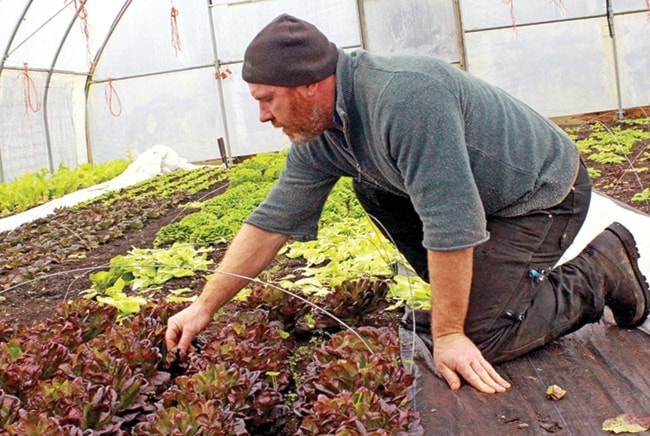With the cost of fresh produce driving inflation and winter farmer's markets active, local farmers say they are optimistic, but need more support.
Recent Statistics Canada showed inflation up to 1.6 per cent this December over the previous December, driven by a 13.3 per cent average increase in the cost of fresh vegetables across the country.
"Many, many, many farmers have joined farming in the last five or six years, before that it was very quiet," said Barbara Ebell of Nanoose Edibles asked about the current state of local farming.
"The weather got drier, the Americans were threatening not to send us anymore food, there were fears of frightening things out there and that drew in farmers, but it unfortunately didn't draw in customers," she said.
Ebell — who local farmers point to as the numbers expert in the area — said she calculated a few years ago that just three per cent of the food eaten on Vancouver Island comes from the Island and the average net farm income from working farms was $20,000.
She said despite the recent popularity of things like farmer's markets, farm gate sales and fresh produce box programs, she doesn't believe the percentage of local food has changed much yet.
For context she said, 25 years ago, when she and her husband got into farming, 20 per cent of Island food was produced here. At the end of the Second World War, it was more like 85 per cent.
The main reason? "People love their grocery stores," which Ebell said is just the habitual nature of humans. "We used to go to church, now we go to grocery stores."
Lorne McCallum of Nourish Farm in Dashwood and former Qualicum Beach Farmer's Market president agrees, adding that while 3,000 or 4,000 visitors seems like a lot at the peak summer markets, he estimates less than one percent of the population shop there regularly.
One of those more recent to farming, McCallum is now well established and says he loves to see others getting into farming, though they could be considered competition.
"When we get 4,000 people at the market and (a new farmer) comes in we shouldn't be fighting for those same customers, we should be working to double the number of people coming to the market, there's a lot of untapped (customers) out there."
While Ebell's 25-year-old Nanoose Edibles is focusing on continuing the success they've built over the years, some, like McCallum, are investing and expanding, betting on a growing customer base.
A couple years ago Nourish Farm built an unheated 3,000 sq.ft. greenhouse, which he and his wife plan to triple in size in the near future, largely to take advantage of the Qualicum Beach Farmer's Market, currently in its second winter season.
Like Ebell and McCallum, Brian Cormie is optimistic, but only grudgingly. Cormie, who started Cormie Farms in Parksville with his brother in 1975, is optimistic because he has to be to keep planting crops every spring, but he's worried local shoppers and politicians aren't doing enough to keep it sustainable long-term.
"There's a lot of talk," he said. "When I started there were many small and medium size farms everywhere, now there's not many and the big farms are really really big."
"Some young people are getting into it, it's trendy, but this is a hard time to get into it, land costs are too high and we're against California which produces five or six crops a year to our one or two, plus they have cheap labour."
He added that the modern complexities can also work for local farmers though, with the California drought last year helping increase prices here.
"Sure the farmer's markets are really busy in the spring," he added, "but that doesn't mean everybody's buying."
McCallum said the current trend should continue to bring local farmers more customers, which will lead to more investment and farm production, which will feed a healthy cycle of increasing local production again.
Ebell agrees, but sees a need for more government support and larger scale work like regional efforts that have been successful in places like Courtenay and Victoria, where she said they have kept their economic development officers through the intervening years, with a real focus on farm and food-initiatives.
She is less optimistic about a natural groundswell changing the market, saying the shift to grocery stores was driven by massive transportation investment making it cheap to bring in food, meaning it will take similar focus on local farms to reverse the trend.
But she does fear that world events and increasing difficulty in getting food will eventually force the issue, pointing out that we're at the end of the delivery chain. "We're at the tail end of the line, and then you have to get on a ferry," she said, suggesting we'd be the first to lose access to food during any large scale problems.
All of the local farmers spoken to for this article were eager to speak to the public about the work local farmers are doing and encouraged interested people to visit them online, during public hours at their farms or at farmer's markets and to continue to educate themselves.
Watch The NEWS for more on local food and farming issues in the near future, including more on the political and grocery story business aspects.
Catch the Qualicum Beach Farmer's Market every Saturday at Veterans Way and Memorial Avenue 8:30 a.m. to noon (www.qbfarmersmarket.com or 1-844-843-7236) and watch for other markets in the area to re-open in the spring.
